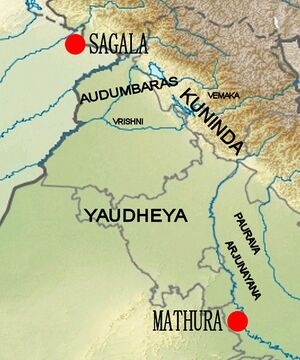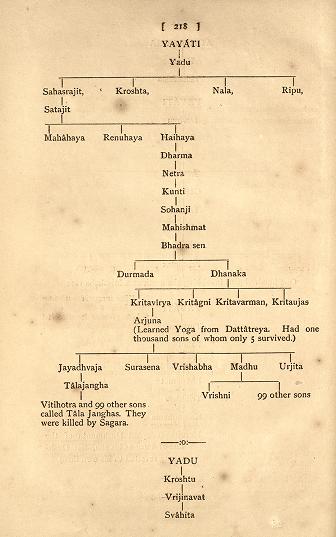Vrishni
| Author:Laxman Burdak, IFS (R) |

Vrishni (वृष्णि) was a descendent of Yadu in Yadav vansh. Vrishni was born as eldest son of Maharaja Madhu in 19th generation of Yadu, the son of Yayati. He is a Chandravanshi Jat Kshatriya. They fought Mahabharata War in Pandava's side
Contents
Variants
- Vrishni वृष्णि (AS, p.870)
- Vrishni Ganarajya (वृष्णि गणराज्य) (AS, p.870)
The Genealogy of Vrishnis

It is believed that Vrishni was son of Satvata, a descendant of Yadu, the son of Yayati. He had two wives, Gandhari and Madri. He has a son named Devamidhusha by his wife Madri. Vasudeva, the father of Krishna was the grandson of Devamidhusha.[1]
Vrishnis were the descendant of Vrishni. Krishna belonged to this branch of the Chandravanshi of Vrishnis from whom he got the name Varshneya. [2] The people of Dwaraka were known as the Vrishnis.
Mention by Panini
Vishvaksena Vrishni (विश्वक्सेन वृष्णि) is mentioned by Panini in Ashtadhyayi. [3]
Vrishni (वृष्णि) is mentioned by Panini in Ashtadhyayi. [4]
Jat clan
Vrishni (वृष्णि)/Brishni (बृष्णि) is a gotra of Jats.[5] [6]
History
Vasudeva Saran Agrawala[7] writes that The Lichchhavis are said to have comprised 7707 rajans living in Vesali, and it is stated in Lilita-vistara that each one of them thought: I am King, I am King. Panini mentions that Vrijis, of whose confederation the Lichchhavis formed part. There is reference in the Jatakas to the Lichchhavi rulers consecrated to rulership by sprinkling sacred water on them (Jat. IV.148). A similar custom prevailed among the Andhaka-Vrishnis and other Sanghas.
V. S. Agrawala[8] writes that besides the Ayudhajivi Sanghas stated as such in the Ashtadhyayi, there were some other communities in Panini’s time, which as we know from other sources were republics. These include :Andhaka- Vrishni (VI.2.34) – The Puranas make them identical with the Satvatas whom Panini mentions as a Sangha in the Ganapatha. The Mahabharata refers to them as a Sangha and so does Kautilya. Panini refers to Rajanya leaders amongst the Andhaka-Vrishnis, which as explained by Kashika denoted members of such families as were entitled to be consecrated to rulership (abhishikta vamsya) . The chief feature of Andhaka-Vrishni constitution appears to be a full-fledged party system. The party of Akrura and that of Vasudeva are referred to by Patanjali showing that the followers of each leader were designated in accordance with their respective party leaders, e.g., Akruta-vargya, Akrura-vargina, and Vasudeva-vargya, Vasudeva –vargina.
In Mahabharata
Vrishni (वृष्णि)(I.61.72), (1.67),(I.177.18), (1.188),(I.221.1,2,5,8), (I.221),(II.48.42),(III.13.1), (III.48.6), 3-255-17b, (V.7.1),(VI.20.14),
Karna's conquests: Vana Parva, Mahabharata/Book III Chapter 255 describes Karna's victory march and countries subjugated. Vrishni (वृष्णि) is mentioned in (3-255-17). [9] ....Then going to Shishupala's son (शैशुपाल) (3-255-16a), the son of the Suta defeated him and that highly powerful one also brought under his sway all the neighbouring rulers. And, O bull of the Bharata race, having subjugated the Avantis (3-255-17a) and concluded peace with them, and having met with the Vrishnis (वृष्णि) (3-255-17b ), he conquered the west.
Migration of Vrishnis to Dwaraka
Jarasandha, father-in-law of Kans, invaded Mathura with a vast army; and though Krishna destroyed his army of demons, another asura, Kalayavan by name, surrounded Mathura with another army of thirty million monstrous fiends. Then Krishna thought it well to depart to Dwaraka. [10]
Wives of Krishna
Krishna had 16,108 wives.
- Rukmini - Krishna married Rukmini, daughter of King Bhishmaka of Vidarbha. He also married
- Mitrabinda,
- Satyabhama,
- Jambavati and others, winning each by great deeds; and another time, when a demon named Bhaumasura carried off and concealed many thousand princesses, Krishna pursued and slew him, and received these also into his house. Each of his wives had ten sons and one daughter.
- Kalindi - While Krishna was ruling at Dwaraka, Duryodhana was oppressing the Pandavas at Hastinapur and sought to compass their death. Krishna and Balarama went to give them help, and it was while Krishna was the Pandavas’ guest that he married Kalindi, daughter of Sun.[11]
End of Vrishnis
After the death of Duryodhana in Mahabharata, Krishna received the curse of his mother. She bewailed the death of her son and of friend and foe; then recognizing Hari as the Prime Mover, the One behind All, she cursed him for letting such things befall. This was her curse: that after 36 years Krishna should perish alone miserably and his people, the Vrishnis, should be destroyed. These things in due time came to pass. A madness seized the people of Dwaraka so that they fell upon one another and were slain, together with all sons and grandsons of Krishna. Only the women and Krishna and Balarama remained alive. Then Balarama went to the forest, and Krishna first sent a messanger to the Kuru city, to place the city and women of Dwaraka under the Pandavas protection, and then took leave of his father; afterward he himself sought the forest, where Balarama awaited him. Krishna discovered his brother seated under a mighty tree on the edge of the forest; he sat like a yogi, and behold, there came forth from his mouth a mighty snake, the thousand headed naga, Ananta, and glided away to ocean. Ocean himself and the sacred rivers and many divine nagas came to meet him. Thus Krishna beheld his brother depart from human world, and he wandered alone in forest. He thought of Gandhari’s curse and all that had befallen, and he knew that the time had come for his own departure. He restrained his senses in yoga and laid himself down. Then there came a hunter that way and thought him a deer, and loosed a shaft and pierced his foot; but when he came close the hunter beheld a man wrapped in yellow robes practicing yoga. Thinking himself an offender, he touched his feet. Then Krishna rose and gave him comfort, and himself ascended to Heaven.[12]
Arjuna went to Dwaraka and brought away the women and children of the Vrishnis, and set out for Kurukshetra. On the way a band of warriors attacked the cavalcade and carried away a great part of women. Arjuna established the others with the remnants of Krishna’s descendants in new cities; but Rukmini and many others of Krishna’s wives became Sati, burning themselves on pyre, and others became ascetics and nuns. The waters of ocean advanced and overwhelmed Dwaraka so that no trace remained.[13]
वृष्णि
वृष्णि (AS, p.870): विजयेन्द्र कुमार माथुर[14] ने लेख किया है .....वृष्णि गणराज्य शूरसेन प्रदेश में स्थित था। वृष्णियों का तथा अंधकों का प्राचीन साहित्य में साथ-साथ उल्लेख है। श्री क़ृष्ण वंश से ही संबंधित [p.871]: पाणिनि 4,1,114 तथा 6,2,34 में वृष्णियों तथा अंधकों का उल्लेख है। कौटिल्य के 'अर्थशास्त्र' (पृ. 12) में वृष्णियों के संघ-राज्य का वर्णन है। 'महाभारत' में अंधक वृष्णियों का श्रीकृष्ण के संबंध में वर्णन है- 'यादवा: कुकुरा भोजा: सर्वे चान्धकवृष्णय:, त्वय्यासक्ता: महाबाहो लोकालोकेश्वराश्च ये।'-- महाभारत शांतिपर्व 81,29.
इसी प्रसंग में श्रीकृष्ण को संघ मुख्य भी कहा गया है, जिससे सूचित होता है कि वृष्णि तथा अंधक गणजातियों के राज्य थे- 'भेदाद् विनाश: संघानां संघमुख्योऽसि केशव'।-- महाभारत शांतिपर्व 81,25
वृष्णियों का हर्षचरित (काॕवेल, पृ.193) में भी उल्लेख है. वृष्णी-संघ का नाम एक सिक्के पर भी अंकित पाया गया है जिसका अभिलेख इस प्रकार है-- 'वृष्णि राजज्ञागणस्य भुभरस्य।' यह सिक्का वृष्णि-गणराज्य द्वारा प्रचलित किया गया था और इसकी तिथि प्रथम या द्वितीय शती ई.पू. है। (दे. मजुमदार-कार्पोरेट लाइफ़ इन ऐंशेंट इंडिया, पृ.280)
वृष्णि: चन्द्रवंशी जाट
दलीप सिंह अहलावत[15] लिखते हैं: यह चन्द्रवंशी जाट गोत्र है। इस वंश का प्रचलन प्राचीनकाल से है। चन्द्रवंशी सम्राट् ययाति के पुत्र यदु की 19वीं पीढी में महाराजा मदु हुए। उसके 100 पुत्रों में सबसे बड़ा वृष्णि था। उसी के नाम पर यह ‘वृष्णि’ वंश प्रसिद्ध हुआ (विष्णु पुराण चतुर्थ अंश अध्याह 11, श्लोक 25)। रामायणकाल में भी इस वंश का जनपद था। महाभारतकाल में इसका वर्णन निम्नलिखित है -
जाट इतिहास के लेखक ठा० देशराज लिखते हैं कि -
- “श्रीकृष्ण जी नारद को बताते हुए कहते हैं - अन्धक और वृष्णि लोग वास्तव में महाभाग, बलवान् और पराक्रमी हैं। ये लोग सदा राजनैतिक (उत्थान) बल से सम्पन्न रहते हैं (पृ० 102 पर महाभारत का निर्देश)। व्रज में वृष्णि लोगों का एक छोटा राज्य था। इस वृष्णिराज्य के अधिपति श्रीकृष्ण के पिता वसुदेव थे। मथुरा के पास कंस ने नवराष्ट्र, गोपराष्ट्र आदि प्रजातन्त्रों को नष्ट करके साम्राज्य की नींव डाली। वसुदेव को कैद में डाल दिया था। कृष्ण जी ने बृज के वृष्णि, अन्धक, नव, गोप लोगों का संगठन बनाकर
जाट वीरों का इतिहास: दलीप सिंह अहलावत, पृष्ठान्त-256
- कंस को मार दिया। जरासंध के आतंक से तंग आकर कृष्ण जी ने वृज छोड़ दी और यहां से अपने साथ वृष्णि, अन्धक, शूर, माधव लोगों को ले जाकर द्वारिका पहुंच गया। वहां जाकर यदुवंशज अंधक वृष्णि दोनों को मिलाकर एक राजनैतिक ज्ञाति नाम का संघ बनाया जो कि प्रजातन्त्री था। ज्ञाति संघ के सदस्यों को ज्ञात कहा जाता था। संस्कृत ज्ञात का प्राकृत जात अथवा जाट बनता है। ज्ञात राज्य जिसकी कृष्ण जी ने नींव डाली, उसमें पहले दो वंश (जाटों के) अन्धक, वृष्णि शामिल हुए, फिर यादव वंशज प्रायः सारा समूह शूर, दशार्ण, भोज, कुन्तिभोज, काम्भोज (सब जाट गोत्र) आदि जातिराष्ट्र के रूप में परिणत हो गये। इस तरह से यह महान् जाट संघ कायम हुआ।” (अधिक जानकारी के लिए देखो, द्वितीय अध्याय, जाटवीरों की उत्पत्ति प्रकरण)।
इस जाति (जाट) संघ ने बड़ी संख्या में महाभारत युद्ध में भाग लिया था। यह वृष्णि गोत्र आज भी जाटों में विद्यमान है।
नोट -
- पाण्डवों के वनवास के समय उनसे मिलने के लिए भोज, वृष्णि, अन्धक वंशों के लोग काम्यक वन में गये थे। (वनपर्व)
- युधिष्ठिर के दो वंशों के लोग कर (टैक्स) नहीं देते थे। सम्बन्ध के कारण पांचालवंश और मित्रता के कारण वृष्णि और अन्धक। (महाभारत सभापर्व, 49वां अध्याय)
- श्रीकृष्ण जी भी वृष्णिवंशज थे। इनको महाभारत में कई स्थानों पर वृष्णिवंशी श्रीकृष्ण लिखा है (द्रोणपर्व अध्याय 127, श्लोक 21-22; द्रोणपर्व अध्याय 156, श्लोक 4; कर्णपर्व अध्याय 17, श्लोक 23; कर्णपर्व अध्याय 79, श्लोक 48)। श्रीकृष्ण जाट थे। इसके प्रमाण यादववंश प्रकरण में दिये हैं।
यदुवंश के शाखागोत्र - : 1. वृष्णि 2. अन्धक 3. हाला 4. शिवस्कन्दे-सौकन्दे 5. डागुर-डीगराणा 6. खिरवार-खरे 7. बलहारा 8. सारन 9. सिनसिनवाल 10. छोंकर 11. सोगरवार 12. हांगा 13. घनिहार 14. भोज ।[16]
References
- ↑ Pargiter F.E. (1922, reprint 1972). Ancient Indian Historical Tradition, Delhi: Motilal Banarsidass, pp.103-7
- ↑ Mahendra Singh Arya et al: Adhunik Jat Itihas,
- ↑ V. S. Agrawala: India as Known to Panini, 1953, p.186
- ↑ V. S. Agrawala: India as Known to Panini, 1953, p.77
- ↑ Jat History Dalip Singh Ahlawat/Parishisht-I, s.n. व-35
- ↑ O.S.Tugania:Jat Samuday ke Pramukh Adhar Bindu, p.50, s.n. 1602
- ↑ India as Known to Panini, p. 428-429
- ↑ V. S. Agrawala: India as Known to Panini, 1953, p.451-452
- ↑ आवन्त्यांश्च वशे कृत्वा साम्ना च भरतर्षभ, वृष्णिभिः सह संम्य पश्चिमामपि निर्जयत् (3-255-17)
- ↑ Myths and Legends of the Hindus and Bhuddhists,
- ↑ Myths and Legends of the Hindus and Bhuddhists,
- ↑ Myths and Legends of the Hindus and Bhuddhists,
- ↑ Myths and Legends of the Hindus and Bhuddhists,
- ↑ Aitihasik Sthanavali by Vijayendra Kumar Mathur, pp.870-871
- ↑ जाट वीरों का इतिहास: दलीप सिंह अहलावत, पृष्ठ.256-257
- ↑ जाट वीरों का इतिहास: दलीप सिंह अहलावत, पृष्ठ.187
Back to Jat Gotras/The Ancient Jats/ Jat Organizations